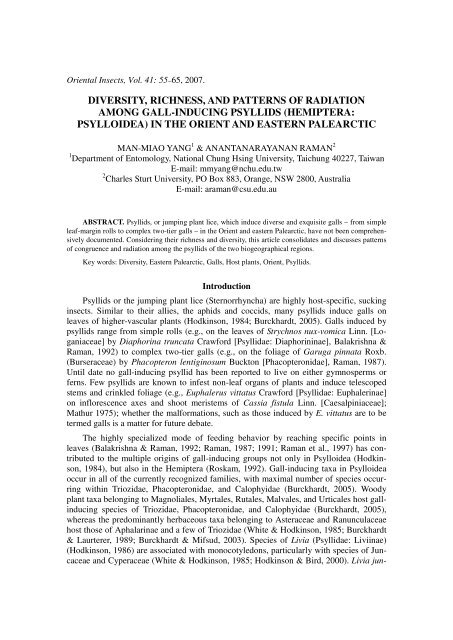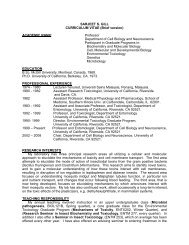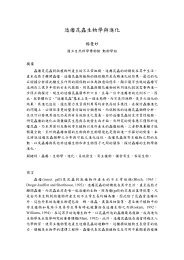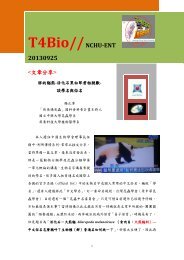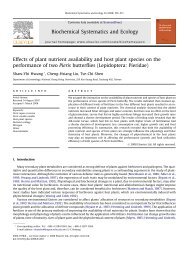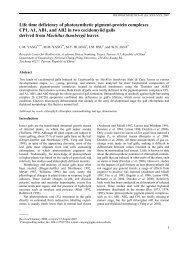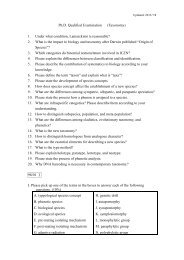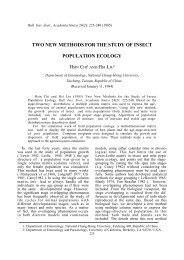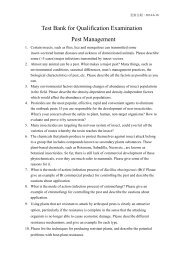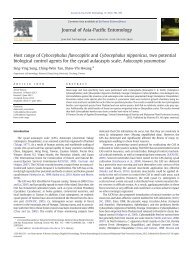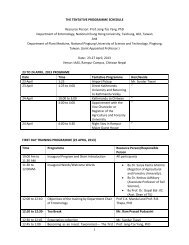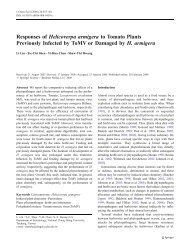diversity, richness, and patterns of radiation among gall-inducing ...
diversity, richness, and patterns of radiation among gall-inducing ...
diversity, richness, and patterns of radiation among gall-inducing ...
Create successful ePaper yourself
Turn your PDF publications into a flip-book with our unique Google optimized e-Paper software.
Oriental Insects, Vol. 41: 55–65, 2007.DIVERSITY, RICHNESS, AND PATTERNS OF RADIATIONAMONG GALL-INDUCING PSYLLIDS (HEMIPTERA:PSYLLOIDEA) IN THE ORIENT AND EASTERN PALEARCTICMAN-MIAO YANG 1 & ANANTANARAYANAN RAMAN 21 Department <strong>of</strong> Entomology, National Chung Hsing University, Taichung 40227, TaiwanE-mail: mmyang@nchu.edu.tw2 Charles Sturt University, PO Box 883, Orange, NSW 2800, AustraliaE-mail: araman@csu.edu.auABSTRACT. Psyllids, or jumping plant lice, which induce diverse <strong>and</strong> exquisite <strong>gall</strong>s – from simpleleaf-margin rolls to complex two-tier <strong>gall</strong>s – in the Orient <strong>and</strong> eastern Palearctic, have not been comprehensivelydocumented. Considering their <strong>richness</strong> <strong>and</strong> <strong>diversity</strong>, this article consolidates <strong>and</strong> discusses <strong>patterns</strong><strong>of</strong> congruence <strong>and</strong> <strong>radiation</strong> <strong>among</strong> the psyllids <strong>of</strong> the two biogeographical regions.Key words: Diversity, Eastern Palearctic, Galls, Host plants, Orient, Psyllids.IntroductionPsyllids or the jumping plant lice (Sternorrhyncha) are highly host-specific, suckinginsects. Similar to their allies, the aphids <strong>and</strong> coccids, many psyllids induce <strong>gall</strong>s onleaves <strong>of</strong> higher-vascular plants (Hodkinson, 1984; Burckhardt, 2005). Galls induced bypsyllids range from simple rolls (e.g., on the leaves <strong>of</strong> Strychnos nux-vomica Linn. [Loganiaceae]by Diaphorina truncata Crawford [Psyllidae: Diaphorininae], Balakrishna &Raman, 1992) to complex two-tier <strong>gall</strong>s (e.g., on the foliage <strong>of</strong> Garuga pinnata Roxb.(Burseraceae) by Phacopteron lentiginosum Buckton [Phacopteronidae], Raman, 1987).Until date no <strong>gall</strong>-<strong>inducing</strong> psyllid has been reported to live on either gymnosperms orferns. Few psyllids are known to infest non-leaf organs <strong>of</strong> plants <strong>and</strong> induce telescopedstems <strong>and</strong> crinkled foliage (e.g., Euphalerus vittatus Crawford [Psyllidae: Euphalerinae]on inflorescence axes <strong>and</strong> shoot meristems <strong>of</strong> Cassia fistula Linn. [Caesalpiniaceae];Mathur 1975); whether the malformations, such as those induced by E. vittatus are to betermed <strong>gall</strong>s is a matter for future debate.The highly specialized mode <strong>of</strong> feeding behavior by reaching specific points inleaves (Balakrishna & Raman, 1992; Raman, 1987; 1991; Raman et al., 1997) has contributedto the multiple origins <strong>of</strong> <strong>gall</strong>-<strong>inducing</strong> groups not only in Psylloidea (Hodkinson,1984), but also in the Hemiptera (Roskam, 1992). Gall-<strong>inducing</strong> taxa in Psylloideaoccur in all <strong>of</strong> the currently recognized families, with maximal number <strong>of</strong> species occurringwithin Triozidae, Phacopteronidae, <strong>and</strong> Calophyidae (Burckhardt, 2005). Woodyplant taxa belonging to Magnoliales, Myrtales, Rutales, Malvales, <strong>and</strong> Urticales host <strong>gall</strong><strong>inducing</strong>species <strong>of</strong> Triozidae, Phacopteronidae, <strong>and</strong> Calophyidae (Burckhardt, 2005),whereas the predominantly herbaceous taxa belonging to Asteraceae <strong>and</strong> Ranunculaceaehost those <strong>of</strong> Aphalarinae <strong>and</strong> a few <strong>of</strong> Triozidae (White & Hodkinson, 1985; Burckhardt& Laurterer, 1989; Burckhardt & Mifsud, 2003). Species <strong>of</strong> Livia (Psyllidae: Liviinae)(Hodkinson, 1986) are associated with monocotyledons, particularly with species <strong>of</strong> Juncaceae<strong>and</strong> Cyperaceae (White & Hodkinson, 1985; Hodkinson & Bird, 2000). Livia jun-
56 Oriental Insects Vol. 41corum Latr., induces organoid <strong>gall</strong>s on the shoots <strong>of</strong> Juncus articulatus Linn. (Juncaceae)(Schmidt, 1966; Schmidt & Meyer, 1966) <strong>and</strong> incidence <strong>of</strong> this species exemplifies thewidth <strong>of</strong> host range <strong>of</strong> <strong>gall</strong>-<strong>inducing</strong> psyllids, more especially because extremely fewmonocotyledons host <strong>gall</strong>-<strong>inducing</strong> insects in general (Raman et al., 2005).Information on global species <strong>of</strong> <strong>gall</strong>-<strong>inducing</strong> psyllids is limited, when comparedwith the information available on <strong>gall</strong>-<strong>inducing</strong> Cecidomyiidae (Diptera) <strong>and</strong> Cynipidae(Hymenoptera). In this article, we have attempted to consolidate information on the <strong>diversity</strong><strong>and</strong> <strong>richness</strong> <strong>of</strong> <strong>gall</strong>-<strong>inducing</strong> psyllids <strong>and</strong> their <strong>gall</strong>s in the Orient <strong>and</strong> easternPalearctic, with specific examples from India <strong>and</strong> Taiwan, exploring some <strong>of</strong> the obvious<strong>patterns</strong> <strong>of</strong> relationships <strong>among</strong> them.Diversity in <strong>gall</strong>-<strong>inducing</strong> psyllids in Eastern Palearctic <strong>and</strong> Oriental regionsInsects capable <strong>of</strong> <strong>inducing</strong> <strong>gall</strong>s appear particularly rich in south-east Asia (Doctorsvan Leeuwen-Reijnvaan & Docters van Leeuwen, 1926), south Asia (Mani, 1973; 2000),<strong>and</strong> the Taiwanese bioregion (Yang & Tung, 1998). However, none <strong>of</strong> these cataloguesfocuses specifically on <strong>gall</strong>-<strong>inducing</strong> psyllids, except that <strong>of</strong> Yang et al. (2006), which hasassessed the <strong>diversity</strong> <strong>of</strong> <strong>gall</strong>-<strong>inducing</strong> psyllids <strong>and</strong> their <strong>gall</strong>s in Taiwan. Information on<strong>gall</strong>-<strong>inducing</strong> psyllids remains either buried in the catalogues <strong>of</strong> <strong>gall</strong>-<strong>inducing</strong> insects referredearlier or scattered in papers dealing primarily with psyllid taxonomy <strong>and</strong>/or briefbiological details (e.g., K<strong>and</strong>asamy & Krishnan, 1981; K<strong>and</strong>asamy & Sharma, 1983;K<strong>and</strong>asamy & Thenmozhi, 1985 a, b; K<strong>and</strong>asamy, 1986; Raman & K<strong>and</strong>asamy, 1978;Thenmozhi & K<strong>and</strong>asamy, 1992, 1993). In an essentially taxonomic treatment <strong>of</strong> thepsyllids <strong>of</strong> the Indian subcontinent, Mathur (1975) has provided brief biological notes onsome <strong>of</strong> the <strong>gall</strong>-<strong>inducing</strong> psyllids. A comprehensive list <strong>of</strong> the psyllids <strong>of</strong> the Orientalzoogeographical region, with veiled references to the <strong>gall</strong>-<strong>inducing</strong> species, is availablein Hodkinson (1986).Taxonomic treatments <strong>of</strong> the psyllids from various provinces <strong>of</strong> China (Yang & Li,1982, 1983, Li, 1991, 1992a, b, c; 1993; Li & Huang, 1995; Wang & Wang, 2000; Li,2004) refer to <strong>gall</strong>-<strong>inducing</strong> species in the genera Cecidopsylla, Celtisaspis,Cornegenapsylla, Heterotrioza, Pauropsylla, Phacopteron, Pseudophacopteron, Rhinopsylla,Trioza, <strong>and</strong> Triozidus (Calophyidae, Psyllidae, Phacopteronidae, <strong>and</strong> Trozidae) <strong>inducing</strong><strong>gall</strong>s on Schima argentea Pritz. (Theaceae), Celtis sinensis Pers. (Ulmaceae), Dimocarpuslongana Lour. (Sapindaceae), Chenopodium album Linn., (Chenopodiaceae),Ficus racemosa Linn. (Moraceae), Garuga sp. (Burseraceae), Alstonia scholaris (Linn.)R. Br. (Apocynaceae), Machilus vericolora S. Lee (Lauraceae), Cinnamomum austrosinesseH. T. Chang (Lauraceae), Acanthopanax brachypus Miq. (Araliaceae). Amongthese, species <strong>of</strong> Celtisaspis, reported only from the ‘China– Korea–Japan’ bioregion appearstriking because they share a disjunctive distribution with its relatives Tetragonocephala<strong>and</strong> Pachypsylla, which are Nearctic genera (Crawford, 1914; Tuthill, 1943; Miyatake,1968, 1980; Kwon, 1983; Yang, 1995).Species <strong>of</strong> Celtisaspis, Tetragonocephala, <strong>and</strong> Pachypsylla form a monophyletictribe Pachypsyllini <strong>and</strong> feed mainly on the leaves <strong>of</strong> Celtis (Urticales: Ulmaceae) (White& Hodkinson, 1985; Yang, 1995). Species <strong>of</strong> Pachypsylla induce <strong>gall</strong>s <strong>of</strong> diverse morphologieson leaves, buds, <strong>and</strong> twigs <strong>of</strong> several species <strong>of</strong> Celtis <strong>and</strong> are common inNorth America (Yang & Mitter, 1994). P. cohabitans Yang & Riemann was recentlyfound to behave as an inquiline, which on losing its ability in <strong>inducing</strong> <strong>gall</strong>s, lives inside<strong>gall</strong>s induced by its sibling pachypsyllid species (Yang et al., 2001). Tetragonocephala, a
2007 Yang & Raman: Gall-<strong>inducing</strong> psyllids (Hemiptera: Psylloidea) 57monotypic genus that forms lerps, is less common <strong>and</strong> confined only to the south <strong>of</strong>United States <strong>and</strong> north <strong>of</strong> Mexico. Lerp-forming species occur also in the genusEuphalerus (Hollis & Martin, 1997) but are particularly diverse <strong>among</strong> the AustralianSpondyliaspidinae (Psyllidae) (White, 1971; Morgan, 1984; Carver et al., 1991; Hollis,2004). Most species <strong>of</strong> Celtisaspis not only induce conspicuous horn <strong>gall</strong>s, but also formlerps at the same time (e.g., C. quizhouana Yang & Li, C. zhejiangana Yang & Li, C.liaoningana Yang & Li); they feed on the underside <strong>of</strong> host leaves, <strong>inducing</strong> pit <strong>gall</strong>s onthe upper sides <strong>of</strong> leaves <strong>and</strong> cover their bodies with lerp along the undersides <strong>of</strong> leaves(Yang & Li, 1982). C. sinica Yang & Li <strong>and</strong> C. beijingana Yang & Li have also beenknown, which either induce pit <strong>gall</strong>s or modest deformations on leaves besides forminglerps. Two species <strong>of</strong> Pachypsylla (= Celtisaspis) from Japan have been reported onCeltis sinensis var. japonica (Planch.) Nakai <strong>and</strong> C. bungeana var. jessoensis (Koidz.)(Miyatake, 1968, 1980; Takagi & Miyatake, 1993). The Japanese Pachypsylla have beentreated as Celtisaspis by Hodkinson (1986): C. japonica Miyatake is bivoltine, whereasC. usubai Miyatake is univoltine. C. japonica induces both dome-shaped lerps <strong>and</strong> horn<strong>gall</strong>s only in their first generations, while the second generation <strong>of</strong>fspring only formlerps. C. usubai can not only form lerps, but also induce pit <strong>gall</strong>s. No inquilines or anyother kind <strong>of</strong> casual visitor species in the <strong>gall</strong>s <strong>of</strong> Palearctic psyllids are known so far. Inthe monograph on Korean psyllids, describing 81 psyllid species <strong>of</strong> 18 genera, Kwon(1983) has briefly referred to Pachypsylla japonica Miyatake (=Celtisaspis japonica Miyatake)on Celtis sinensis var. japonica, but no mention <strong>of</strong> <strong>gall</strong>-<strong>inducing</strong> habit <strong>of</strong> either P.japonica or any other species has been provided.Further to Celtisaspis, close to 45 species <strong>of</strong> <strong>gall</strong>-<strong>inducing</strong> psyllids placed in 19 genera<strong>and</strong> three families have been recorded from Japan (Yukawa & Masuda, 1996): Anomoneura,Aphalara, Celtisaspis, Craspedolypta, Euphalerus, Togepsylla, Livia, Psylla,Syntomoza (Psyllidae), Metapsylla (Calophyidae), Epitrioza, Leptynoptera, Pauropsylla,Petalolyma, Stenopsylla, Trichochermes, <strong>and</strong> Trioza (Triozidae) (Yukawa & Masuda,1996). Plants belonging to 22 families host <strong>gall</strong>-<strong>inducing</strong> psyllids: Aquifoliaceae, Araliaceae,Chenopodiaceae, Ebenaceae, Elaeagnaceae, Euphorbiaceae, Fagaceae, Flacourtiaceae,Clusiaceae (= Guttiferae), Juncaceae, Lardizabalaceae, Lauraceae, Leguminosae,Meliaceae, Moraceae, Pittosoraceae, Polygonaceae, Rhamnaceae, Sapotaceae, Styracaceae,Symplocaceae, <strong>and</strong> Ulmaceae. A majority <strong>of</strong> host plants <strong>of</strong> Japanese <strong>gall</strong>-<strong>inducing</strong>psyllids (19 out <strong>of</strong> 45) fall within Eurosids I, followed by Asterids <strong>and</strong> Eudicots (Table1). Two-thirds <strong>of</strong> Japanese <strong>gall</strong>-<strong>inducing</strong> psyllids belong to Triozidae <strong>and</strong> the seven Asterids<strong>and</strong> three Euasterids-II host plants are associated with triozids. Only Metapsylla, thesingular calophyid <strong>of</strong> Japan is associated with a plant genus belonging to Eurosids-II.
58 Oriental Insects Vol. 41Table 1. Gall-<strong>inducing</strong> Psyllid families <strong>and</strong> their hosts in Japan 1Psyllid familyPlant group 2 Calophyidae Psyllidae TriozidaeTotalMagnoliids - 1 3 4Monocots - 1 - 1Eudicots - 4 2 6Rosids - - - -Eurosid I - 7 12 19Eurosid II 1 - - 1Euasterids II - - - -Euasterids II - - 3 3Asterids - - 7 7Unknown - 1 3 4Total 1 14 30 451 Adapted from Yukawa & Masuda, 1996.2 Phylogenetic categories <strong>of</strong> plant families are in accordance with Angiosperm Phylogeny Group (2003).Richness <strong>and</strong> <strong>diversity</strong> <strong>of</strong> <strong>gall</strong>-<strong>inducing</strong> psyllidsin the Indian subcontinent <strong>and</strong> TaiwanTaiwanNearly two decades ago, 19 <strong>gall</strong>-<strong>inducing</strong> psyllid species were recorded by Yang(1984). In this record, Triozidae included 17 species placed in Cecidotrioza, Eustenopsylla,Homotrioza, Neophacopteraon, Parastenopsylla, Pseudotrioza, <strong>and</strong> Trioza,Phacopteronidae included one species <strong>of</strong> Pseudophacopteron, <strong>and</strong> Psyllidae included onespecies <strong>of</strong> Psylla (Yang, 1984). These species have been reported to be <strong>inducing</strong> <strong>gall</strong>s onleaves (e.g., pit <strong>gall</strong>s, leaf folds, leaf rolls, marginal folds, spherical protruding <strong>gall</strong>s) <strong>of</strong>species <strong>of</strong> Daphniphyllaceae, Burseraceae, Theaceae, Lauraceae, Symplocaceae, Sapindaceae,Ericaceae, Euphorbiaceae, Pittosporaceae, Flacourtiaceae, Elaeocarpaceae, <strong>and</strong>Myrtaceae. A recent survey (Yang et al., 2006) has revealed a more extensive range <strong>of</strong>plant families that host <strong>gall</strong>-<strong>inducing</strong> psyllids. In addition to those reported by Yang(1984), the Yang et al. (2006) report refers to the following plant families that host <strong>gall</strong><strong>inducing</strong>psyllids: Lardizabalacaeae, Sabiaceae, Proteaceae, Clusiaceae, Pittosporaceae,Fabaceae, Fagaceae, Moraceae, Ulmaceae, Meliaceae, Actinidiaceae, Ebenaceae, Sapotaceae,Styracaceae, Acathaceae, Aquifoliaceae, Araliaceae, Pittosporaceae, Asteraceae, <strong>and</strong>Caprifoliaceae, with 75% <strong>of</strong> the recorded <strong>gall</strong>s induced on leaves, <strong>and</strong> the remainder oneither shoot axes (17.5 %) or flowers <strong>and</strong> fruits (7.5%). The Yang et al. (2006) report,however, clarifies that Lauraceae (e.g., Machilus, Cinnamomum) <strong>and</strong> Moraceae (e.g., Ficus)hosted the maximum number <strong>of</strong> <strong>gall</strong>-<strong>inducing</strong> psyllids. Notwithst<strong>and</strong>ing the fact thatYang et al. (2006) have not listed the psyllid taxa, a comparison <strong>of</strong> Yang (1984) <strong>and</strong> Yanget al. (2006) reports reveals the following (Table 2):• a majority <strong>of</strong> <strong>gall</strong>-<strong>inducing</strong> psyllids occur on the relatively primitive tree speciesbelonging to Lauraceae (Magnoliids: Laurales) <strong>and</strong> Myrtaceae (Rosids: Myrtales)
2007 Yang & Raman: Gall-<strong>inducing</strong> psyllids (Hemiptera: Psylloidea) 59• recently recorded psyllids <strong>and</strong> their <strong>gall</strong>s occur on trees <strong>of</strong> relatively advancedplant families belonging to Eurosids I <strong>and</strong> Euroisids II• psyllids <strong>and</strong> their <strong>gall</strong>s have also been recorded on advanced plant families thatinclude predominantly herbaceous species belonging to Asterids, Euasterids I, <strong>and</strong>Euasterids II• psyllid species that are capable <strong>of</strong> <strong>inducing</strong> <strong>gall</strong>s on shoot axes (stems <strong>and</strong> buds)also occur.Table 2. Gall-<strong>inducing</strong> Psyllid families <strong>and</strong> their hosts in Taiwan 1Plant group 2 Host species Gall types 3Magnoliids 25 30Monocots - -Eudicots 7 7Rosids 10 13Eurosid I 24 24Eurosid II 2 2Euasterids I 1 1Euasterids II 8 8Asterids 12 13Total 89 981 Adapted from Yang et al. (2006).2 Phylogenetic categories <strong>of</strong> plant families are in accordance with Angiosperm Phylogeny Group (2003).3 Shape <strong>of</strong> <strong>gall</strong>s on each plant species <strong>and</strong> plant part has been considered as one <strong>gall</strong> type. As psyllids arehost specific, each <strong>gall</strong> type is likely to represent a specific <strong>gall</strong>-<strong>inducing</strong> species.IndiaA majority <strong>of</strong> the psyllids that induce <strong>gall</strong>s (e.g., pit <strong>gall</strong>s, leaf folds, leaf rolls, marginalfolds, round-protruding <strong>gall</strong>s) belong to Psyllidae (e.g., Diaphorina [Diaphorininae],Livia [Liviinae], Paurocephala [Paurocephalinae]), Calophyidae (e.g., Apsylla, Calophya),Phacopterinidae (Phacopteron), <strong>and</strong> Triozidae (e.g., Cecidotrioza, Ceropsylla,Cryptotrioza, Egeirotrioza, Neotrioza, Pauropsylla, Pseudotrioza, Trioza). Nearly all theknown species <strong>of</strong> the Oriental Triozidae are <strong>gall</strong>-<strong>inducing</strong> species (e.g., Mathur, 1975;K<strong>and</strong>asamy, 1986) (Table 3). Indotrioza hirsuta K<strong>and</strong>asamy, a <strong>gall</strong>-<strong>inducing</strong> species onthe leaves <strong>of</strong> Vaccinium neilgherrensis (Ericaceae) from the semi-dry vegetation alongthe eastern slopes <strong>of</strong> the Eastern Ghats (The Shevroys; 1650 m asl; 11°40′N; 78°8′E) <strong>and</strong>Ceropsylla indica K<strong>and</strong>asamy, another <strong>gall</strong>-<strong>inducing</strong> species on the leaves <strong>of</strong> Terminaliaarjuna Wight & Arnold (Combretacae) from the coastal plains <strong>of</strong> peninsular India (Madrascity; 13°3″N; 80°13′E) have been added in the mid-1980s (K<strong>and</strong>asamy, 1986). IndianTriozidae are, by <strong>and</strong> large, restricted to arborescent species confined to Lauraceae(Magnoliids: Laurales), Sabiaceae (Eudicots), Combretaceae (Rosids: Myrtales), Euphorbiaceae(Eurosids I: Malpighiales), Salicaceae (Eurosids I: Malpighiales), Moraceae (EurosidsI: Rosales), Urticaceae (Eurosids I: Rosales), Ericaceae (Asterids: Ericales), <strong>and</strong>Ebenaceae (Asterids: Ericales). With reference to Ceropsylla indica K<strong>and</strong>asamy, which
60 Oriental Insects Vol. 41induces <strong>gall</strong>s on the flowers <strong>of</strong> Terminalia arjuna (Combretaceae), K<strong>and</strong>asamy (1986)has remarked that species <strong>of</strong> Teminalia appear as the most preferred host species <strong>of</strong>Triozidae. Mycopsylla gardenensis (Bhanotar, Ghosh, & Ghosh) (Homotomidae) is a singularnon-triozid species recorded as a <strong>gall</strong> inducer on Ficus religiosa (Moraceae) insouthern India (K<strong>and</strong>asamy, 1986). Several species <strong>of</strong> Indian figs (Ficus spp., Moraceae)preferentially host several species <strong>of</strong> Homotomidae (e.g., Dynopsylla, Homotoma,Macrohomotoma) <strong>and</strong> Paurocephalinae (e.g., Paurocephala). Only two Triozidae (e.g.,Ceropsylla, Pauropsylla) are also associated with Ficus-species as <strong>gall</strong> inducers (Hodkinson,1986).A comparison <strong>of</strong> distribution <strong>and</strong> host relations <strong>of</strong> <strong>gall</strong>-<strong>inducing</strong> psyllid taxa betweenIndia <strong>and</strong> Taiwan <strong>of</strong>fers several insights into the associations between particular psyllidgenera <strong>and</strong> specific plant families. For example, Calophyidae (e.g., Apsylla <strong>and</strong> Calophya)are associated with Sapindales (Anacardiaceae, Burseraceae, <strong>and</strong> Rutaceae) <strong>and</strong>Cecidopsylla with Ericales (Theaceae) (Mathur, 1975; Yang, 1984; Burckhardt & Basset,2000). The diversification <strong>of</strong> the Indo-Australian genus Cecidopsylla demonstrates a distinctpattern: the Asian species <strong>of</strong> Cecidopsylla developed primarily on the Himalayanelement Schima wallichii (Theaceae; Asterids: Ericales) <strong>and</strong> has diversified simultaneouslywith the trans-Himalayan diversification <strong>and</strong> spread <strong>of</strong> S. wallichii (Hu, 1980),whereas the Australian species <strong>of</strong> Cecidopsylla developed on Proteaceae (Eudicots: Proteales)<strong>and</strong> Rutaceae (Eurosids II: Sapindales), because they occurred outside the geographicalrange <strong>of</strong> Schima, separated by the oceanic barrier. The Asian Cecidopsylla induceleaf-roll <strong>gall</strong>s, whereas the Australian Cecidopsylla induce pit <strong>gall</strong>s (Burckhardt,1991). Diversification <strong>of</strong> Dynopsylla (Homotomidae) appears strongly aligned with Ficus;D. gr<strong>and</strong>is Crawford induces <strong>gall</strong>s on the leaves <strong>of</strong> Ficus talbolti King (Moraceae) inIndia (Mani, 1973; Mathur 1975) <strong>and</strong> D. pinnativena (Enderlein) induces <strong>gall</strong>s on theleaves <strong>of</strong> F. nervosa Heyne (Moraceae) in Taiwan (Yang, 1984). Livia khaziensis Heslop-Harrison (Liviinae) occurs on Juncus bufonius Linn. (Juncaeae) in Indian Himalaya; L.khaziensis (recorded as L. nigra Klimaszewski) occurs on J. prismatocarpus R.Br. in theeastern Palearctic (Hodkinson, 1986). Phacopteron lentiginosum Buckton (Phacopterinidae)induces complex, two-tier <strong>gall</strong>s on the leaflets <strong>of</strong> Garuga pinnata (Burseraceae)(Raman, 1987) <strong>and</strong> is distributed extensively in India, irrespective <strong>of</strong> local climate vagaries;Neophacopteron euphoriae Yang (Phacopterinidae) induces simple pit <strong>gall</strong>s on theleaves <strong>of</strong> Euphoria longan Lam. (Sapindaceae) in Taiwan (Yang, 1984; Yang et al.,2006). What is striking is that both Phacopterinidae share <strong>gall</strong>-<strong>inducing</strong> behavior <strong>and</strong> theyinfest species belonging to Sapindales (Eurosids II). Nonetheless, Pseudophacopteronalstonia Yang & Li induces <strong>gall</strong>s on Alstonia scholaris R. Br. (Apocynaceae; Euasterids I:Gentianales) in China, Ps. canarium Yang & Li on Canarium album Raeusch (Burseraceae;Asterids: Ericales), Ps. floccosum (Crawford) on Aglaia roxburghiana Wight &Arnold (Meliaceae; Eurosids II: Sapindales) in Sri Lanka <strong>and</strong> the central-Pacific Isl<strong>and</strong>s,<strong>and</strong> Ps. tuberculatum (Crawford) on AlstoniaTable 3. Gall-<strong>inducing</strong> Triozidae in the Indian SubcontinentTrioza species Host plant Plant family ReferenceT. eugenoides Not known Ramakrishna, 1924T. hirsuta Terminalia alata Combretaceae Mani, 1948T. lobata Duabanga gr<strong>and</strong>iflora Mathur, 1975T. malloticola Mallotus phillippiensis Euphorbiacceae Mani, 1973T. serrata* Sabia paniculata Sabiaceae Mathur, 1975
2007 Yang & Raman: Gall-<strong>inducing</strong> psyllids (Hemiptera: Psylloidea) 61T. pitiformis Mallotus phillippiensis Euphorbiacceae Mathur, 1975T. vitiensis Syzygium jambolana Myrtaceae Mani, 1959T. analis Not known Mathur, 1975T. beesoni* Litsea spp. Lauraceae Mathur, 1975T. bifurcate* Populus sp. Salicaceae Mathur, 1975T. brevigenae Ficus sp. Moraceae Mathur, 1975T. camphorae Cinnamomum camphora Lauraceae Mani, 1973T. fletcheri Trewia nudiflora Euphorbiaceae Mathur, 1975T. fletcheri minor Terminalia spp. Combretaceae Mathur, 1975T. fusca Syzygium cumini Myrtaceae Mathur, 1975T. gigantea Vaccinium neilgherrense Ericaceae K<strong>and</strong>asamy, 1986T. jambolanae Syzygium cumini Myrtaceae Mani, 1973T. longiantennata* Populus euphratica Salicaceae Mathur, 1975T. obsolete Diospyros melenoxylon Ebenaceae Mathur, 1975T. spinulata Syzygium cumini Myrtaceae Mathur, 1975T. simplifica* Terminalia travancorensis Combretaceae K<strong>and</strong>asamy, 1986T. urticae* Urtica spp. Urticaceae Mathur, 1975*Species that occur restricted to Indo-Gangetic plains <strong>and</strong> the Himalaya. Unasterisked species occurthroughout the Indian subcontinent irrespective <strong>of</strong> climatic variations.scholaris R. Br. (Apocynaceae; Euasterids I: Gentianales) in India (Mathur, 1975; Hodkinson,1983; Yang & Li, 1983). Whereas <strong>gall</strong>-<strong>inducing</strong> behavior is retained <strong>among</strong> theOriental taxa <strong>of</strong> Phacopteridae * , Ps. tuberculatum <strong>and</strong> Ps. alstonia have radiated on toplant families that are not related to Sapindales. The capability <strong>of</strong> Ps. tuberculatum <strong>and</strong>Ps. alstonia to invade A. scholaris, a taxon <strong>of</strong> Apocynaceae, <strong>and</strong> induce <strong>gall</strong>s on them isstriking, given that the latex <strong>of</strong> Apocynaceae includes strong compounds that are toxic tophytophagous insects (Uysal et al., 2005).ConclusionDocumented information on <strong>gall</strong>-<strong>inducing</strong> psyllids <strong>of</strong> the Orient <strong>and</strong> the easternPalearctic points them to be highly specific to their recorded host plants. However, thiscomment needs to be viewed with considerable caution, because modest oligophagy<strong>among</strong> adult insects <strong>of</strong> central-European Triozidae <strong>and</strong> Neotropical Calophyidae isknown (Burckhardt & Basset, 2000; Burckhardt & Lauterer, 2002). Moreover, severalpredatory insects from Anthocoridae, Miridae, Syrphidae, <strong>and</strong> Chrysopidae (Hodkinson& Flint, 1971) <strong>and</strong> parasitic insects from Encyrtidae, Eulophidae, Eupelmidae, Eurytomidae,Pteromalidae, Torymidae, <strong>and</strong> Chalcodoidea (Jansen, 1957) are associated with <strong>gall</strong><strong>inducing</strong>psyllids <strong>and</strong> their <strong>gall</strong>s in the western Palearctic <strong>and</strong> Nearctic; unfortunately, noreliable data from the Orient <strong>and</strong> eastern Palearctic are available. Triozidae appears todominate as the principal <strong>gall</strong>-<strong>inducing</strong> family in the Orient <strong>and</strong> eastern Palearctic, whichis followed by relatively fewer species <strong>of</strong> the Calophyidae <strong>and</strong> Phacoteronidae. Variationin morphologies <strong>of</strong> <strong>gall</strong>s induced by the Oriental psyllids ranges from simple leaf-marginrolls induced by Diaphorininae (e.g., Diaphorina truncata on Strychnos nux-vomica) atone extreme to complex two-tier <strong>gall</strong>s induced by Phacopteronidae (e.g., Phacopteronlentiginosum on Garuga pinnata) on the other. Species <strong>of</strong> Triozidae induce <strong>gall</strong>s that fitbetween the two above-identified extremes by <strong>inducing</strong> spherical <strong>and</strong> protruding <strong>gall</strong>s on* D. Burckhardt, while reviewing this manuscript (pers. comm.. email: 14 June 2007) commented: “This is not true forthe world fauna: nearly half <strong>of</strong> the species <strong>of</strong> Pseudophacopteron from Cameroon induce <strong>gall</strong>s <strong>and</strong> the other half donot.”
62 Oriental Insects Vol. 41leaves (e.g., Pauropsylla depressa on Ficus recemosa Linn. [= F. glomerata Roxb.](Mani, 1973; Mathur, 1975), Trioza jambolanae Crawford on Syzigium cumini (Linn)Skeels (Raman, 1991), Trioza fletcheri minor Crawford on Terminalia tomentosa Wight& Arnold <strong>and</strong> T. arjuna Wight & Arnold (Raman et al., 1997). Host relations <strong>of</strong> IndianTriozidae have been experimentally tested with Trioza fletcheri minor; karyology <strong>of</strong> thepopulations <strong>of</strong> the triozids reared from mature <strong>gall</strong>s <strong>of</strong> Terminalia tomentosa <strong>and</strong> T. arjunaindicated them to be <strong>of</strong> identical chromosomal configuration (Raman et al., 1997)pointing that the same triozid induces <strong>gall</strong>s (<strong>of</strong> similar morphology) on two species <strong>of</strong>Terminalia. T. f. minor has been recorded as a <strong>gall</strong> inducer not only on T. tomentosa <strong>and</strong>T. arjuna, but also on T. catappa Linn., T. paniculata Roth, <strong>and</strong> T. tomentosa x T. arjuna,which are distributed almost uniformly throughout India (Champion & Seth 1968;Mathur, 1975; Hodkinson, 1986). Galls on the flowers <strong>of</strong> T. arjuna were reported to beinduced by Trioza sp (T. f. minor[?], Sokhi & Kapil, 1984; 1985), but we currently knowthat these <strong>gall</strong>s are induced by Cerospylla indica (Triozidae) (K<strong>and</strong>asamy, 1986).A cursory evaluation <strong>of</strong> the pattern <strong>of</strong> association <strong>of</strong> <strong>gall</strong>-<strong>inducing</strong> psyllids <strong>of</strong> theOrient <strong>and</strong> eastern Palearctic with their respective host-plant taxa indicates that themaximum number <strong>of</strong> psyllids are associated with arborescent species <strong>of</strong> Eurosids (AngiospermPhylogeny Group, The, 2003), whereas relatively few are associated with theprimitive Magnoliids <strong>and</strong> relatively advanced Asterids; whether such a pattern has anevolutionary context <strong>and</strong> meaning, is an issue remaining to be explored.AcknowledgementsWe thank Daniel Burckhardt (Naturhistorisches Museum, Basel, Switzerl<strong>and</strong>) forreviewing this article. We are grateful to V. V. Ramamurthy (Indian Agricultural ResearchInstitute, New Delhi, India) <strong>and</strong> B. V. David (Sun Agrochemicals, Madras, India) forsupplying a few key papers on Indian psyllids.ReferencesANGIOSPERM PHYLOGENY GROUP, THE, 2003. An update <strong>of</strong> the Angiosperm Phylogeny Groupclassification for the orders <strong>and</strong> families <strong>of</strong> flowering plants: APG II. Botanical Journal <strong>of</strong> the LinneanSociety, 141: 399–436.BALAKRISHNA, P. & RAMAN, A., 1992. Cecidogenesis <strong>of</strong> leaf <strong>gall</strong>s <strong>of</strong> Strychnos nux-vomica(Loganiaceae) induced by the jumping plant louse species Diaphorina truncata (Homoptera:Psylloidea: Psyllidae). Entomologia Generalis, 17: 285–292.BURCKHARDT, D., 1991. Notes on the Indo-Australian plant-louse genus Cecidopsylla (Homoptera:Psylloidea) with descriptions <strong>of</strong> two new species. Phytophaga (Madras), 3: 73–86.BURCKHARDT, D., 2005. Biology, ecology, <strong>and</strong> evolution <strong>of</strong> <strong>gall</strong>-<strong>inducing</strong> psyllids (Hemiptera: Psylloidea).In: Raman, A., Schaefer C. W., & Withers T. M. (eds) Biology, ecology, <strong>and</strong> evolution <strong>of</strong> <strong>gall</strong><strong>inducing</strong>arthropods. Science Publishers, New Hampshire, USA. Pp. 143–158.BURCKHARDT, D. & LAURTERER, P., 1989. Systematics <strong>and</strong> biology <strong>of</strong> the Rhinocolinae (Homoptera:Psylloidea). Journal <strong>of</strong> Natural History, 223: 643–712.BURCKHARDT, D. & LAURTERER, P., 2002. Revision <strong>of</strong> the Central European Trioza rotundata Florcomplex (Hemiptera: Psylloidea): taxonomy <strong>and</strong> bionymy. Mittelungen Schweizerischen EntomologischenGesselschaft, 75: 21–34.BURCKHARDT, D. & MIFSUD, D., 2003 Jumping plant lice <strong>of</strong> the Paurocephalinae (Insecta, Hemiptera,Psylloidea): systematics <strong>and</strong> phylogeny. Contributions to Natural History, Bern, 2: 3–34.BURCKHARDT, D. & BASSET, Y., 2000. The jumping plant-lice (Hemiptera, Psylloidea) associated withSchinus (Anacardiaceae): systematics, biogeography <strong>and</strong> host plant relationships. Journal <strong>of</strong> NaturalHistory, 34: 57-155CARVER, M., GROSS, G..F. & WOODWARD, T. E., 1991. Hemiptera. In: CSIRO. The Insects <strong>of</strong>Australia, Vol. 1, 2nd edition, Melbourne University Press, Melbourne, Australia.
2007 Yang & Raman: Gall-<strong>inducing</strong> psyllids (Hemiptera: Psylloidea) 63CHAMPION, H. G. & SETH, S. K., 1968. A revised survey <strong>of</strong> the forest types <strong>of</strong> India. Government <strong>of</strong>India Press, New Delhi, India. 404 pages.CRAWFORD, D. L., 1914. A monograph <strong>of</strong> the jumping plant-lice or Psyllidae <strong>of</strong> the new World. Bulletin<strong>of</strong> the US National Museum, 85: 1–186.DOCTORS VAN LEEUWEN-REIJNVAAN, J. & DOCTERS VAN LEEUWEN, W. M., 1926. The zoocecidia<strong>of</strong> the Netherl<strong>and</strong>s East Indies. Drukkerj de Unie, Batavia, Indonesia. 601 pages.HODKINSON, I. D., 1980. Present-day distribution <strong>patterns</strong> <strong>of</strong> the holarctic Psylloidea (Homoptera: Insecta)with particular reference to the origin <strong>of</strong> the nearctic fauna. Journal <strong>of</strong> Biogeography, 3: 333–360.HODKINSON, I. D., 1984. The biology <strong>and</strong> ecology <strong>of</strong> <strong>gall</strong>-forming Psylloidea (Homoptera). In: T. N.Ananthakrishnan (ed.) Biology <strong>of</strong> <strong>gall</strong> insects. Oxford & IBH Publishing Company, New Delhi, India.59–77 pages.HODKINSON, I. D., 1986. The psyllids (Homoptera: Psylloidea) <strong>of</strong> the Oriental zoogeographical region:an annotated checklist. Journal <strong>of</strong> Natural History, 20: 299–357.HODKINSON, I. D. & FLINT, P. W. H., 1986. Some predators from the <strong>gall</strong>s <strong>of</strong> Psyllopsis fraxini L(Hem., Psyllidae). Entomologist’s Monthly Magazine, 107: 11–12.HODKINSON, I. D. & BIRD, J., 2000. Sedge <strong>and</strong> rush-feeding psyllids <strong>of</strong> the subfamily Liviinae (Insecta:Hemiptera: Psylloidea): a review. Zoological Journal <strong>of</strong> Linnaean Society, 128: 1–49.HOLLIS, D., 2004. Australia Psylloidea, jumping plant lice <strong>and</strong> lerp insects. Australian Biological ResourcesStudy, Canberra, Australia. 216 pages.HOLLIS, D. & MARTIN, J. H., 1997. Jumping plant lice (Insecta: Hemiptera) attacking Lonchocarpusspecies (Leguminosae), including 'Black Cabbage Bark', in Belize. Journal <strong>of</strong> Natural History, 31:237–267.HU, S. Y., 1980. The Metasequoia flora <strong>and</strong> its phytogeographic significance. .Journal <strong>of</strong> Arnold Arboretum,61: 41–94.JANSEN, D. D., 1957. Parasites <strong>of</strong> Psyllidae. Hilgardia, 27: 71–99.KANDASAMY, C., 1980. A new leaf <strong>gall</strong> by Trioza gigantea Craw. (Homoptera: Psyllidae) on Vacciniumneilgherrense W. (Vacciniaceae). Current Science, 49: 754.KANDASAMY, C., 1986. Taxonomy <strong>of</strong> south Indian psyllids. Records <strong>of</strong> the Zoological Survey <strong>of</strong> India.84: 1–110.KANDASAMY, C. & KRISHNAN, B. H., 1981. First record <strong>of</strong> leaf <strong>gall</strong>s on Litsea stocksii (Meissn.)Hook. f. (Lauraceae) caused by a psyllid. Current Science, 50: 967–968.KANDASAMY, C. & SHARMA, R. M., 1983. A new psyllid <strong>gall</strong> on the leaves <strong>of</strong> Alstonia kurzii H.K.F.(Apocynaceae) from the south Andaman Isl<strong>and</strong>s. Current Science, 52: 934–935.KANDASAMY, C. & THENMOZHI, K., 1985a. New record <strong>of</strong> leaf vein <strong>gall</strong> on Pterocarpus marsupiumRoxb. (Leguminosae) induced by a psyllid. Current Science, 54: 288–289.KANDASAMY, C. & THENMOZHI, K., 1985b. New record <strong>of</strong> Diaphorina dakariensis Boselli <strong>and</strong>Euphalerus marginalis Capener (Homoptera: Psyllidae) from India. Entomon, 10: 339–340.KWON, Y. J., 1983. Psylloidea <strong>of</strong> Korea (Homoptera: Sterrnorrhyncha). Insecta Koreana Series, 2: 1–181.LI, F., 1991. Pauropsylla <strong>and</strong> a Chinese new record – Pauropsylla depressa. Plant Protection, 17:12–13.LI, F., 1992a. Descriptions <strong>of</strong> genus Cecidopsylla <strong>and</strong> a new Chinese record <strong>of</strong> species C. schimae Kieffer<strong>and</strong> its last instar nymph. Plant Protection, 18: 17–18.LI, F., 1992b. Notes <strong>of</strong> one species <strong>of</strong> Psyllidae from Mt. Mogan (Homoptera: Psyllidae). Journal <strong>of</strong> ZhejiangForestry College, 9: 402–404.LI, F., 1992c. Homoptera: Psylloidea. Insect <strong>of</strong> Wuling Mountains Area, Southwestern China, 132–140pages.LI, F., 1993. Two new species <strong>of</strong> the genus Rhinopsylla Riley from China (Homoptera: Psylloidea: Triozidae).Wuyi Science Journal, 10: 25–28.LI, F., 2004. Homoptera: Psylloidea: Phacopteronidae, Aphalaridae, Calophyidae, Psyllidae <strong>and</strong> Triozidae.In: Yang, Xingke (ed.) Insects from Mr. Shiw<strong>and</strong>ahan Area <strong>of</strong> Guangxi. China Forestry PublishingHouse, Beijing, 213–226 pages.LI, Y. & HUANG, B., 1995. A preliminary study <strong>of</strong> the longan psyllid Cornegenapsylla sinica Yang et Li.Entomological Journal <strong>of</strong> East China, 4: 38–42.LIU, G., Li, Y, & SU, H., 1997. Preliminary study <strong>of</strong> Heterotrioza chenopodii (Reuter). Journal <strong>of</strong> LiaoningForest Science & Technology, 2: 34–35.MANI, M. S., 1948. Cecidozoa <strong>and</strong> zoocecidia from India. Journal <strong>of</strong> the Royal Asiatic Society <strong>of</strong> Bengal(Science), 14: 27–195.MANI, M. S., 1959. Cecidotheca Indica. Agra University Journal <strong>of</strong> Research (Science), 8: 9–280.
64 Oriental Insects Vol. 41MANI, M. S., 1973. Plant <strong>gall</strong>s <strong>of</strong> India (1st edition), Macmillan India, New Delhi, India. 354 pages.MANI, M. S., 2000. Plant <strong>gall</strong>s <strong>of</strong> India (2nd edition), Science Publishers, Inc., New Hampshire, USA. 495pages.MATHUR, R. N., 1975. Psyllidae <strong>of</strong> the Indian subcontinent. Indian Council <strong>of</strong> Agricultural Research, NewDelhi. 429 pages.MIYATAKE, Y., 1968. Pachypsylla japonica, sp. nov., a remarkable lerp-forming psyllid from Japan. Bulletin<strong>of</strong> Osaka Museum <strong>of</strong> Natural History, 21: 5–12.MIYATAKE, Y., 1980. Notes on the genus Pachypsylla <strong>of</strong> Japan with description <strong>of</strong> a new species (Homoptera:Psyllidae). Bulletin <strong>of</strong> Osaka Museum <strong>of</strong> Natural History, 33: 61–70..MORGAN, F. D., 1984. Psylloidea <strong>of</strong> South Australia. H<strong>and</strong>book <strong>of</strong> the Flora <strong>and</strong> Fauna <strong>of</strong> South Australiaseries. 136 pages.RAMAKRISHNA, T. V., 1924. List <strong>of</strong> Psyllidae recorded from India <strong>and</strong> Ceylon. Records <strong>of</strong> the IndianMuseum, 26: 621–625.RAMAN, A., 1987. On the cecidogenesis <strong>and</strong> nutritive tissues <strong>of</strong> the leaf <strong>gall</strong>s <strong>of</strong> Gaurga pinnata Roxburgh(Burseraceae) induced by Phacopteron lentiginosum Buckton (Pauropsyllinae: Psyllidae: Homoptera).Phytophaga (Madras) 1: 141–159.RAMAN, A., 1991. Cecidogenesis <strong>of</strong> leaf <strong>gall</strong>s on Syzigium cumini (L.) Skeels (Myrtaceae) induced byTrioza jambolanae Crawford (Homoptera: Psylloidea). Journal <strong>of</strong> Natural History, 25: 653–663.RAMAN, A. & KANDASAMY, C., 1978. Leaf <strong>gall</strong>s on Symplocos spicata (Roxb.) (Symplocaceae) causedby Trioza sp. (Homoptera: Psyllidae). Current Science, 47: 127–128.RAMAN A., SINGH, R. N., & MARYANSKA-NADACHOWSKA, A., 1997. Biology <strong>and</strong> karyology <strong>of</strong> acecidogenous psylloid, Trioza fletcheri minor (Homoptera: Psylloidea) <strong>and</strong> morphogenesis <strong>of</strong> <strong>gall</strong>s onthe leaves <strong>of</strong> Terminalia tomentosa <strong>and</strong> T. arjuna (Combretaceae). Insecta Matsumurana (New Series),53: 117–134.RAMAN, A., SCHAEFER, C. W., & WITHERS, T. M., 2005. Galls <strong>and</strong> <strong>gall</strong>-<strong>inducing</strong> arthropods: an overview<strong>of</strong> their biology, ecology, <strong>and</strong> evolution. In: Raman, A., Schaefer, C.W., & Withers, T. M. (eds)Biology, ecology, <strong>and</strong> evolution <strong>of</strong> <strong>gall</strong>-<strong>inducing</strong> arthropods. Science Publishers, Inc., New Hampshire,USA. 1–33 pages.ROSKAM, J. C., 1992. Evolution <strong>of</strong> <strong>gall</strong>-<strong>inducing</strong> guild. In: Shorthouse, J. D. & Rohfritsch, O. (eds) Biology<strong>of</strong> insect-induced <strong>gall</strong>s. Oxford University Press, New York, USA. 34–50 pages.SCHMIDT, E.,1966. Cycle biologique et phase cécidogènes de Livia juncorum Latr. Marcellia, 33: 223–235.SCHMIDT, E. & MEYER, J.,1966. Observations sur la structure des <strong>gall</strong>es de Livia juncorum Latr. surJuncus articulatus L. Marcellia, 33: 237–253.SOKHI, J. & KAPIL, R. N., 1984. Morphogenetic changes induced by Trioza in flowers <strong>of</strong> Terminalia arjuna— I. Androecium. Phytomorphology, 34: 117–128.SOKHI, J. & KAPIL, R. N., 1985. Morphogenetic changes induced by Trioza in flowers <strong>of</strong> Terminalia arjuna—II. Gynoecium. Phytomorphology, 35: 69–82.TAKAGI, S. & MIYATAKE, Y., 1993. SEM observations on two lerp-forming psylloids (Homoptera). InsectaMatsumurana, 49: 69–104.TUTHILL, L. D., 1943. The psyllids <strong>of</strong> America north <strong>of</strong> Mexico (Psyllidae: Homoptera). Iowa State CollegeJournal <strong>of</strong> Science, 17: 443–660.THENMOZHI, K. & KANDASAMY, C., 1992. Studies <strong>of</strong> the biology <strong>of</strong> <strong>gall</strong> psyllids <strong>of</strong> India. I.Pauropsylla longispiculata Mathur (Psyllidae: Homoptera). Agricultural & Biological Research, 8:44-47.THENMOZHI, K. & KANDASAMY, C., 1993. Description <strong>of</strong> adult <strong>and</strong> nymphal stages <strong>of</strong> two new <strong>gall</strong>psyllids (Psyllidae: Homoptera) from India. Journal <strong>of</strong> Bombay Natural History Society, 90: 479-487.UYSAL, H., KAYA, Y. & AGAR, G., 2005. Toxic effects <strong>of</strong> aqueous extract <strong>of</strong> Nerium ole<strong>and</strong>er (Apocynaceae)leaves <strong>and</strong> its latex on total protein level in fruit fly Drosophila melanogaster (Diptera: Drosophilidae).Fresenius Environmental Bulletin, 14: 616–619.WANG, W. & WANG, W., 2000. Preliminary study on Triozidus acanthopanaicis. Forest Pest Disease, 4:18-19.WHITE, T. C. R., 1971. Lerp insects (Homoptera, Psyllidae) on red gum (Eucalyptus camaldulensis) inSouth Australia. South Australian Naturalist, 46: 20–23.WHITE, I. M. & HODKINSON, I. D., 1985. Nymphal taxonomy <strong>and</strong> systematics <strong>of</strong> the Psylloidea. Bulletin<strong>of</strong> the British Museum (Natural History), 50: 153–301.YANG, C. T., 1984. Psyllidae <strong>of</strong> Taiwan. Taiwan Museum Special Publication Series, Volume 3, TaiwanMuseum, Taipei, Taiwan.
2007 Yang & Raman: Gall-<strong>inducing</strong> psyllids (Hemiptera: Psylloidea) 65YANG, M. M., 1995. Biosystematics <strong>and</strong> the evolution <strong>of</strong> <strong>gall</strong> formation in hackberry psyllids Pachypsylla(Insecta: Homoptera: Psylloidea: Psyllidae). Ph.D. dissertation. University <strong>of</strong> Maryl<strong>and</strong>, Maryl<strong>and</strong>,USA. 208 pages.YANG, C. K. & LI, F., 1982. Description <strong>of</strong> the new genus Celtisaspsis <strong>and</strong> five new species <strong>of</strong> China(Homoptera: Psyllidae). Entomotaxonomia 4: 183–198.YANG, C. K. & LI, F., 1983. Studies on the genus Bharatiana Muthur with descriptions <strong>of</strong> three new speciesfrom China. Acta Agriculture Universitatis Pekinensis, 9: 51–59.YANG, M. M. & MITTER, C., 1994. Biosystematics <strong>of</strong> hackberry psyllids (Pachypsylla) <strong>and</strong> the evolution<strong>of</strong> <strong>gall</strong> <strong>and</strong> lerp formation in psyllids (Homoptera: Psylloidea): a preliminary report. USDA ForestService, North-central Forest Experiment Station, General Technical Report, NC–174. pages 172–185.YANG, M. M., MITTER, C. & MILLER, D. R., 2001. First incidence <strong>of</strong> inquilinism in <strong>gall</strong>-forming psyllids,with a description <strong>of</strong> the new inquiline species (Insecta, Hemiptera, Psylloidea, Psyllidae,Spondyliaspidinae). Zoologica Scripta, 30: 97-113.YANG, M. M. & TUNG, G. S., 1998. The <strong>diversity</strong> <strong>of</strong> insect-induced <strong>gall</strong>s on vascular plants in Taiwan: apreliminary report. USDA Forest Service, North-central Forest Experiment Station, General TechnicalReport, NC–174, 44–53 pages.YANG, M. M., LIAO, L. H., LOU, M. F., CHEN, W. C., HUANG, S. S., TUNG, G. S., WENG, Y. C. &SHEN, C. C., 2006. Diversity, biology, <strong>and</strong> nutritional adaptation <strong>of</strong> psyllids <strong>and</strong> their <strong>gall</strong>s in Taiwan.In: Ozaki, K., Yukawa, J., Ohgushi, T. & Price, P. W. (eds), Galling Arthropods <strong>and</strong> their Associates.Springer, Tokyo, 33–42 pages.YUKAWA, J. & MASUDA, H., 1996. Insect <strong>and</strong> mite <strong>gall</strong>s <strong>of</strong> Japan in color (in Japanese). Zenkoku NôsonKyôiku Kyôkai, Tokyo, Japan. 826 pages.


